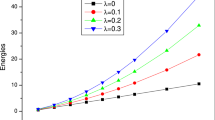Summary
A path-integral representation is constructed for propagators corresponding to quantum Hamiltonian operators obtained from classical Hamiltonians by an arbitrary rule of correspondence. Each rule yields a unique way of defining the path integral in the context of a formalism which does not require a limiting process. This formalism is more reliable than the usual lattice definition in that all the expressions it entails are well defined for computational purposes and it allows the explicit evaluation of large classes of path integrals. Direct substitution in the Schrödinger equation shows that there are no restrictions on the Hamiltonian operator. Examples are given.
Riassunto
Si costruisce una rappresentazione dell’integrale del percorso per propagatori correspondenti ad operatori quanto-hamiltoniani ottenuti da hamiltoniane clamiche mediante una regola arbitraria di corrispondenza. Ogni regola fornisce un unico modo di definire l’integrale del percorso nel contesto di una formalismo che non richiede un processo limitante. Questo formalismo è più attendibile della solita definizione reticolare in quanto tutte le espressioni che esso comprende sono ben definite per fare calcoli ed esso permette una valutazione esplicita di grandi classi di integrali di percorso. La sostituzione diretta nell’equazione di Schrödinger mostra che non ci sono restrizioni sull’operatore hamiltoniano. Si danno esempi.
Резюме
Конструируется представление интегралов по траекториям для пропагаторов, соответствующих квантовым операторам Гамильтона, которые получаются из классических Гамильтонианов с помощью произвольного правила соответствия. Каждое правило дает единственный способ определения интеграла по траекториям в контексте формализма, который не требует предельного процесса. Этот формализм является более надежным, чем обычное решеточное определение, в том смысле, что все выражения точно определены для вычислительных целей, и что этот формалузм допускает точное вычисление больших классов интегралов по траекториям. Непосредственная подстановка в уравнение Шредингера показывает, что не существует ограничений на оператор Гамильтона. Поиводятся примеры.
Similar content being viewed by others
References
M. M. Mizrahi:J. Math. Phys. (N.Y.),16, 2201 (1975).
L. Cohen:J. Math. Phys. (N.Y.),17, 597 (1976).
J. S. Dowker:J. Math. Phys. (N.Y.),17, 1873 (1976).
M. M. Mizrahi:J. Math. Phys.,19, 298 (1978).
L. Cohen:J. Math. Phys. (N.Y.),7, 781 (1966).
However, if one is interested only in a perturbation series in α of the propagator corresponding toH=[g(t) P 2/2m+f(t) Q 2/2+k(t)(PQ+QP)/2+αH 1(P, Q,t)], then the method described here applies directly.
A similar formalism obtained by different methods can be found inC. DeWitt-Morette, A. Maheshwari andB. Nelson:Gen. Rel. Grav.,8, 581 (1977).
M. M. Mizrahi:J. Math. Phys. (N.Y.),17, 566 (1976).
M. M. Mizrahi:J. Comp. Appl. Math.,1, 273 (1975).
The proof of (19) is similar to the one given in ref. (8).
This scheme for correspondence rules was also used inM. M. Mizrahi:J. Math. Phys. (N.Y.),18, 786 (1977), to determine the range of validity of a commonly used formula for the WKB approximation of the propagator <q b ,t b |q a ,t a >.
This formula can be proved by left-multiplying both sides of (28) by exp [i(Q u’+P v’)/ħ], taking traces (note thatA ≡ ∫dq <q|A|q> = ∫dp <dp <p|A|p>), and inserting complete sets of states after using eq. (32).
In thek-expansion of the left-hand side of (73), the vanishing of the 0th-order term results from the Schrödinger equation forK 0, the vanishing of the coefficient ofk results from (65) and the vanishing of the coefficients ofk 2 tok n+1 is what (74) (fromn=2 ton+1) proves.
Author information
Authors and Affiliations
Additional information
Traduzione a cura della Redazione.
Перевебено ребакцией.
Rights and permissions
About this article
Cite this article
Mizrahi, M.M. Correspondence rules and path integrals. Nuov Cim B 61, 81–98 (1981). https://doi.org/10.1007/BF02721705
Received:
Published:
Issue Date:
DOI: https://doi.org/10.1007/BF02721705



